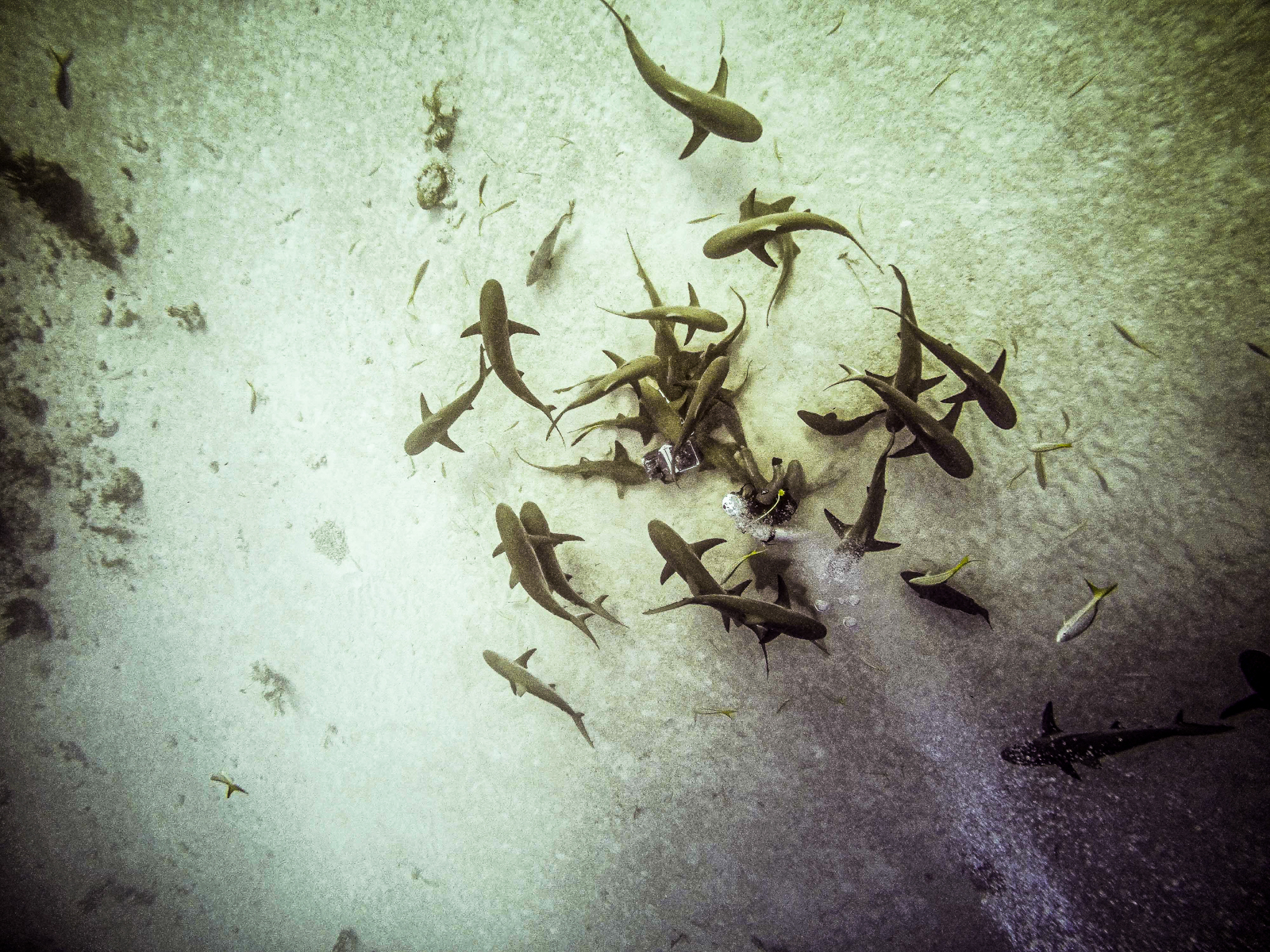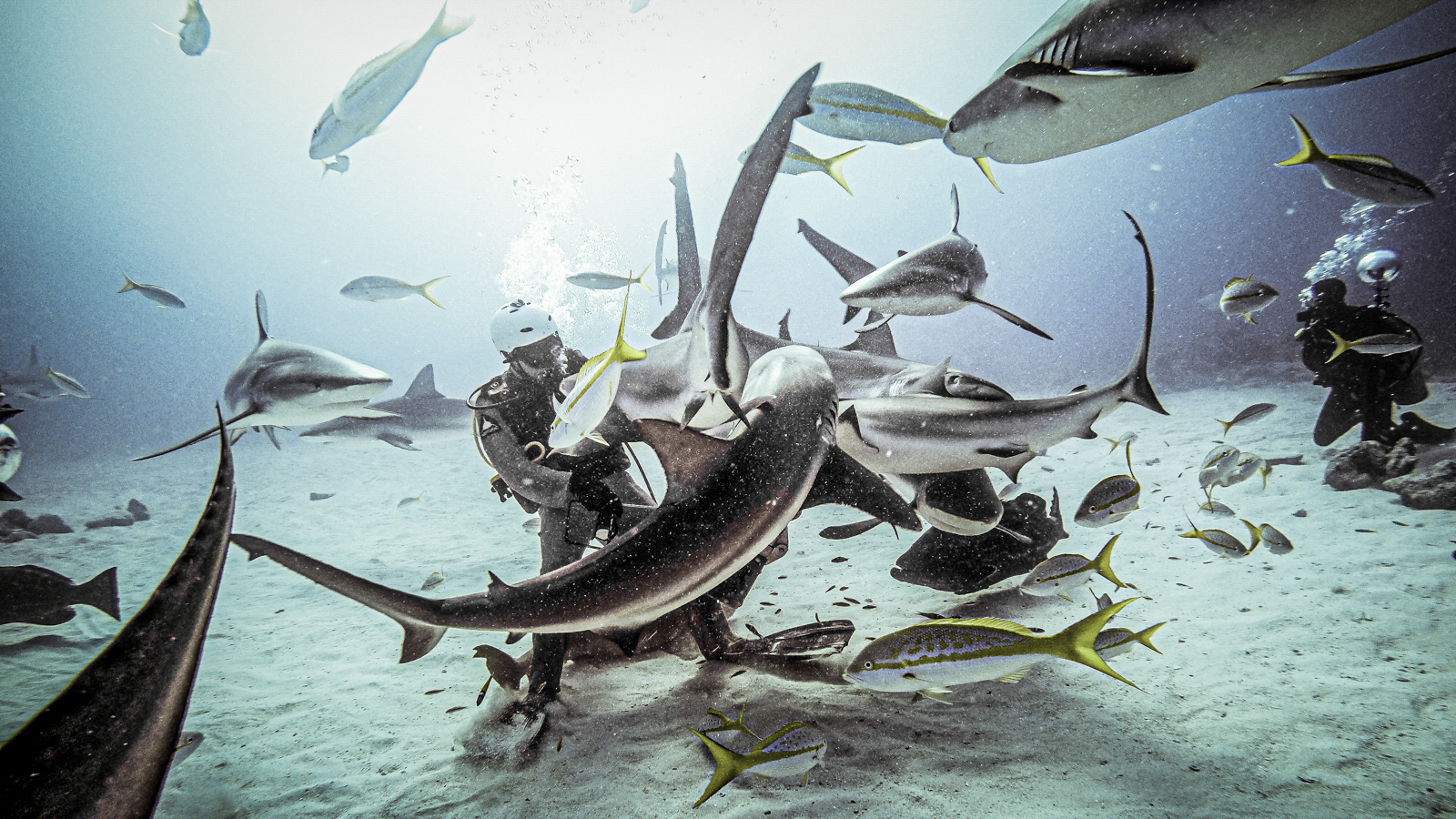The boat slows, and a few sharks have already arrived, sporadic whips of their tails propelling them in swift circles with deadly ease.
We don our dive gear, roll backwards off the bulwarks, and descend to the white, sandy bottom, swimming past corals and groupers and parrotfish to the ring of stones that lines the feeding circle. Each diver must stay at their assigned stone, remain still, and—literally—keep their hands to themselves.
One hundred and fifty million years ago, back when Antarctica was still attached to India, and the Himalayas were still deep underwater, sharks were putting the final evolutionary touches to an array of hunting hardware so effective that they’ve barely had to tweak it since. This was 85 million years before the dinosaurs disappeared, and another 60 million before a small ape in what would become Ethiopia started walking on two legs instead of four. It’s been less than half a million years—a geological blink—since our own furless, big-headed ancestors began picking up spears and lighting fires, beginning a prolific and seemingly unstoppable run of diverse environmental onslaught.
Sharks, in short, are a hard and ancient breed, and—all playing fields being level—we have never been much of a match. Still, your chances of being taken by a shark are exceedingly small. In all of the world, for the entirety of 2022, only nine people were killed by sharks.
That same year, about 2,000 of us lost our lives to lightning. Many more fell to our deaths—not from a cliff, or a tall building, but from our own beds. Sharks kill fewer people than faulty ladders, falling coconuts, and errant champagne corks. You might have heard that you’re more likely to be killed by a vending machine than by a shark, but that’s not true. Those numbers are about the same.
Sharks, then, are about as dangerous as vending machines, which means you’re as likely to be ambushed and eaten by a wild pelagic fish as you are to be crushed under a brick of metal and electricity you tipped onto yourself because your packet of peanut M&Ms didn’t quite make it all the way out of E5.
A rational mind might infer that sharks pose next to no threat. But about such matters we are not often rational. Nor, often, are we very nice. Shark fin soup, historically a rare delicacy of the Chinese elite but now sought widely by booming middle classes all over Asia and beyond, is the main driver behind the callous deaths of 100 million sharks every year.

Not everywhere in the world do sharks suffer such cruel disdain. Here in the Bahamas, for example, you can pay good money (you pay good money to do anything in the Bahamas) to swim with sharks while they are being fed.
Yes, our rampant abuse of sharks comfortably outweighs the danger we face. But is it really a good idea to go swimming with them? While they’re being fed? They are, after all, still sharks—swift, sharp-toothed creatures that carry a look of permanent prehistoric hunger when left well alone, and that would surely find themselves frenzied by water filled with bleeding fish.
This is not untrue. But there are enough of us on this balmy Bahamian afternoon with the necessary scuba certificates, stillness of nerve, and depth of pocket to give it a go.
The boat pokes out of the harbour and skips over whitecaps while the crew prepare tanks and rinse out snorkels. Halfway to the horizon, a tanker picks its way through the reefs, its holds filled with the combustibles that give the Bahamas its electricity, its cars their petrol, and this boat the fuel to propel itself the half dozen nautical miles of warm, shallow water to a place known as the Shark Arena.

Thirteen metres under the water, we sit at our stones, fold our arms, and wait. The feeder, clad in chainmail, enters from above and starts dispensing fish bits from a metal box, like a Pied Piper of the deep, a yearning trail of sharks in his blood-stained wake. Soon, the meal is in full swing.
The sharks, predominantly Caribbean reefs and a few lemons and nurses, swarm and weave in a blitz of quick teeth, fins, and steely eyes. They’re very large and very fast, darting in and out of the circle, glancing occasionally off my mask or wetsuit, inspiring precisely the sort of pupil-expanding, bowel-relaxing, tack-sharp awareness of the fragility of my own single and temporary existence that you might imagine.
It is in this moment of healthy existential arousal that I recall reading that no one has ever died during a shark-feeding dive in the waters around Nassau. At the time, I had not inferred that this probably meant at least one person has been bitten.
When the food is gone, the sharks begin to disperse. A few still make investigative, nuzzling approaches at the fish box, each gentle plea deflected by a tender downward thrust of the feeder’s palm to the snout.
We leave the water in soggy awe, with dripping fins and big grins, and make our way back to the harbour. The tanker we saw earlier is now docked, dispensing its fuel, its hull looming even larger in an early evening mirage.
There is no longer any corner of the world unaffected by the movement of human goods, fuel, and money, but the global economy can sometimes be played to the planet’s advantage. Organizations such as the World Land Trust purchase millions of acres of forest and wilderness to protect them from development. Programs like 1% for the Planet divert companies’ cash back toward environmental protection. Trophy-hunting tenures in British Columbia’s Great Bear Rainforest are bought up by wolf and bear conservationists. And tiger tours in India bring revenue to local communities and a powerful motivation to preserve habitats.
An argument for the feeding of sharks as entertainment might be hard to make, but it is plainly better than slaughtering them for their appendages in an effort to impress other people at dinner. Shark tourism in the Bahamas brings in a lot of money—and a little bit of hope for the future of sharks.









